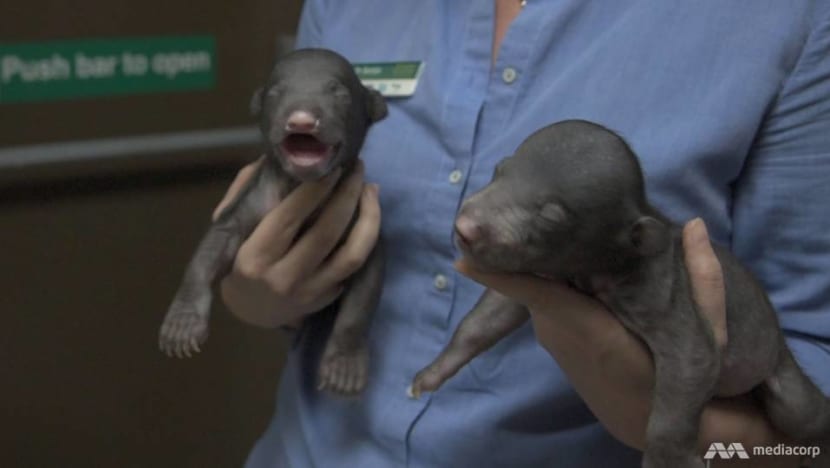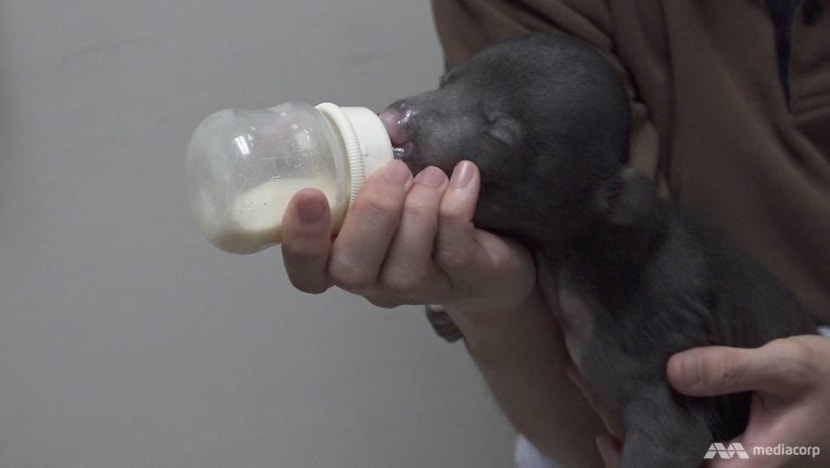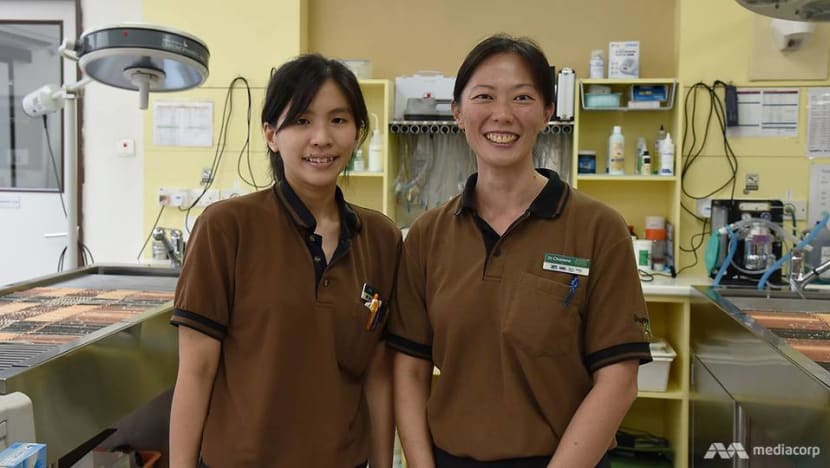Playing mother to sloth bear cubs: Regular feeds, interrupted sleep and unexpected rewards

Two baby sloth bears being carried at the Wildlife Healthcare & Research Centre in Singapore. (Photo: Marcus Mark Ramos)
SINGAPORE: It is 2am and it is time for two little ones to be fed. Ms Clara Yeo is awake even before her phone alarm rings. Her body clock has grown used to the timing - it’s been more than a month after all.
But it is not any baby she is going to attend to. Waiting for their four-hourly feeds in their incubator are two sloth bear cubs. Born at the Night Safari on Sep 13 and 14, they are being hand-reared.
Ms Yeo is a vet nurse who works alongside three vets as part of the team in charge of taking care of cubs just as their mother would. When Channel NewsAsia went to watch one of these feeds, the cubs wailed in anticipation - just like human babies.
In fact, it is hard not to think of Ms Yeo as their parent. She thinks about the cubs constantly, she said. And her pride is evident.
“Every time you weigh them, and you know they are putting on weight, you know you are doing a good job. There’s this sense of fulfilment and achievement, and it’s great to watch them grow up slowly. It’s kind of like your own child,” Ms Yeo told Channel NewsAsia at the Wildlife Healthcare & Research Centre within the zoo where she works.
She is also starting to be able to tell them apart based on their behaviour.
“You can really tell that they have distinct personalities. One is a bit sweeter, it’s a little calmer, a little bit more patient during the (feeding) process. The other cub, the bigger one, she is a little bit more energetic,” Ms Yeo said.

The team sleeps in the hospital after a day of working in order to do night feeds once or twice a week. They either sleep in sleeping bags or on a thick mattress. A carefully planned schedule means that they get to rest the day after their night duties.
Ms Yeo is in parent mode even on her days off.
“I find that sometimes on my days off, I wake up in the middle of the night, anticipating that I have to start preparing milk for the cubs,” she said.
Dr Charlene Yeong, a vet on the team, echoed her sentiment. “When you’re off, you wonder what’s happening with the cubs, and you ask the rest in the chat group if they are okay,” she said.
MAKING IT FEEL LIKE HOME
The team has done what it can to simulate the cubs’ natural environment. From finding a teat the cubs are most comfortable with to keeping their incubator as warm, humid and dark as needed, the cubs are in surroundings as similar as possible to nature, Dr Yeong said.
In the incubator is a soft cuddly toy for the cubs to snuggle up to, and they do so, climbing over it as they would their mother.
The team even stimulates the cubs’ genitals using lubricant and warm water, simulating their mother’s licking to get them to urinate and defecate.
The stimulation is done after feeds. Their milk mixture, which is part baby formula and part milk meant for puppies, has previously been used in successful hand-raising efforts overseas. The amount of milk that is fed to each cub is precise - 37 ml for the bigger one, and just 2 ml less for the smaller one, based on body weight.

They are slightly more than a kilogramme each now, but if they grow up to be like their mother, they could weigh 150kg.
The cubs' milestones come amid eager anticipation, and every slight anomaly is a cause for concern.
Dr Yeong and Ms Yeo recalled how initially there was some diarrhoea, and one day, when it looked like one of the cubs had not pooped the whole day, there was some concern.
“By the next feeding, it was pooping, it was a good volume, and we were just happy to inform each other that the cub pooped,” Ms Yeo said. Pooping means that they are not suffering from constipation or obstipation, both of which can lead to severe problems.
“I think I am the happiest when they poo. That’s really nice,” Dr Yeong said, laughing.
The next milestone the team awaits is the opening of the cubs' eyes. That typically happens when they are about a month old. When they do, the cubs will be handed over to the zoology team, which will continue feeding them milk before starting them on semi-solid food at about the three-month mark.
WHY HAND-RAISE THEM?
The cubs are being hand-raised to give them the best chance at survival, Dr Yeong said.
“The last successful birth of sloth bears that we had that have lived to adults was back in the 90s, and we have never had a successful birth since then,” she said.
The last time the cubs’ mother gave birth to a cub was in 2016. It lived for only two days before it was found dead in the den. Dr Yeong said sloth bears have a history of abandoning or killing their cubs.
“Considering how valuable these bears are, how important they are from the conservation perspective, plus the history of the mothers killing their cubs, we decided to intervene this time, to give them the best shot,” she said.
There are estimated to be 7,000 to 10,000 sloth bears in the world, Dr Yeong said. Their population is declining, however, and they are currently considered vulnerable on the International Union for Conservation of Nature's Red List, which assesses the global conservation status of animals.
Around the world, there are 250 to 300 sloth bears in captivity.
PLANS TO REINTEGRATE CUBS WITH MOTHER
Ms Yeo said that the zoology team already has a reintroduction plan, which is to reunite the cubs and their mother within three to five months.
“That will be the critical stage, when it’s more likely that the female bear will accept the cubs back,” she said.
She added that they do not want to rush the process because it can cause negative behaviour in the adult bear, and they do not want to risk the young bears being injured. The cubs will have to be big enough to fend for themselves.
Dr Yeong said it will be a “very gradual introduction”.
“Initially, it’s just introducing them through a barrier and gauging the reaction of the individuals, and if that goes well, we can introduce the duration of the interaction, we can also do things like exchanging bedding material so there’s the smells, and they can get used to one another that way,” Dr Yeong said.

In the meantime, the team is waiting for the cubs to be back where they belong.
“We are all pretty attached. It has been more than four weeks already, since we started being the primary carers for the cubs, but they are not humans, they are bears. The intention has always been for them to go back to zoology and to be with other bears,” Dr Yeong said.
But that has not stopped her from wondering about their future.
She said: “I think we are all just worried for them, just like you know, you would worry about a baby growing up to be a good person.”














